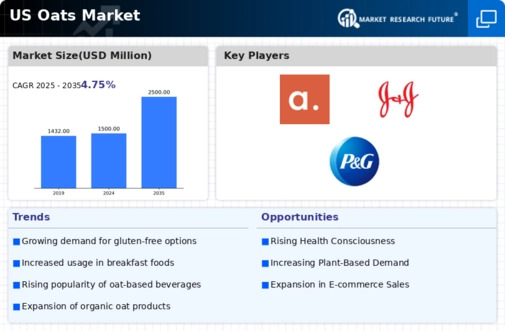Innovations in Product Development
Innovations in product development are significantly influencing the oats market. Manufacturers are increasingly introducing new oat-based products, such as ready-to-eat meals, snacks, and gluten-free options, catering to diverse consumer preferences. The market for oat-based snacks alone is projected to grow at a CAGR of 8% from 2025 to 2030, reflecting the rising interest in convenient and healthy food options. Additionally, advancements in processing techniques have enabled the creation of high-quality oat products that retain their nutritional value while enhancing taste and texture. This focus on innovation not only attracts new consumers but also encourages existing customers to explore a wider range of oat-based offerings, thereby bolstering the oats market.
Rising Demand for Plant-Based Foods
The increasing consumer preference for plant-based diets is a notable driver in the oats market. As more individuals adopt vegetarian and vegan lifestyles, the demand for oats, a versatile and nutritious grain, continues to rise. In 2025, the plant-based food market in the US is projected to reach approximately $74 billion, with oats being a key ingredient in various products such as oat milk, granola bars, and breakfast cereals. This shift towards plant-based eating habits not only supports health-conscious choices but also aligns with the growing awareness of environmental sustainability. Consequently, the oats market is likely to benefit from this trend, as consumers seek healthier alternatives to traditional animal-based products.
Growing Popularity of Breakfast Cereals
The growing popularity of breakfast cereals is a key driver for the oats market. As breakfast remains a crucial meal for many consumers, the demand for convenient and nutritious options continues to rise. Oat-based cereals, known for their health benefits and versatility, are increasingly favored by consumers seeking quick yet wholesome breakfast solutions. In 2025, the breakfast cereal market in the US is expected to reach approximately $14 billion, with oats playing a central role in this segment. This trend is further supported by the increasing number of health-conscious individuals who prioritize whole grains in their diets. Consequently, the oats market stands to gain from the sustained interest in breakfast cereals.
Impact of E-commerce on Food Purchasing
The impact of e-commerce on food purchasing is reshaping the landscape of the oats market. With the rise of online grocery shopping, consumers are increasingly turning to digital platforms to purchase food products, including oats. This shift has been accelerated by the convenience and accessibility that e-commerce offers, allowing consumers to explore a wider variety of oat products than what is typically available in physical stores. In 2025, online grocery sales in the US are projected to account for over 20% of total grocery sales, indicating a significant change in consumer behavior. As e-commerce continues to grow, it is likely to enhance the visibility and availability of oat-based products, thereby driving growth in the oats market.
Increased Awareness of Nutritional Benefits
The oats market is experiencing growth due to heightened awareness of the nutritional benefits associated with oats. Rich in dietary fiber, vitamins, and minerals, oats are recognized for their role in promoting heart health and aiding digestion. Recent studies indicate that incorporating oats into daily diets can lower cholesterol levels by up to 10%, making them an attractive option for health-conscious consumers. As educational campaigns and health initiatives continue to emphasize the importance of whole grains, the demand for oats is expected to rise. This trend is particularly relevant in the US, where consumers are increasingly seeking foods that contribute to overall well-being, thereby driving growth in the oats market.














Leave a Comment